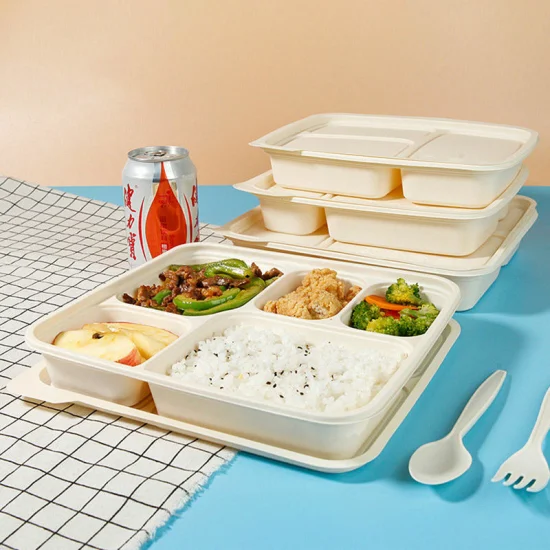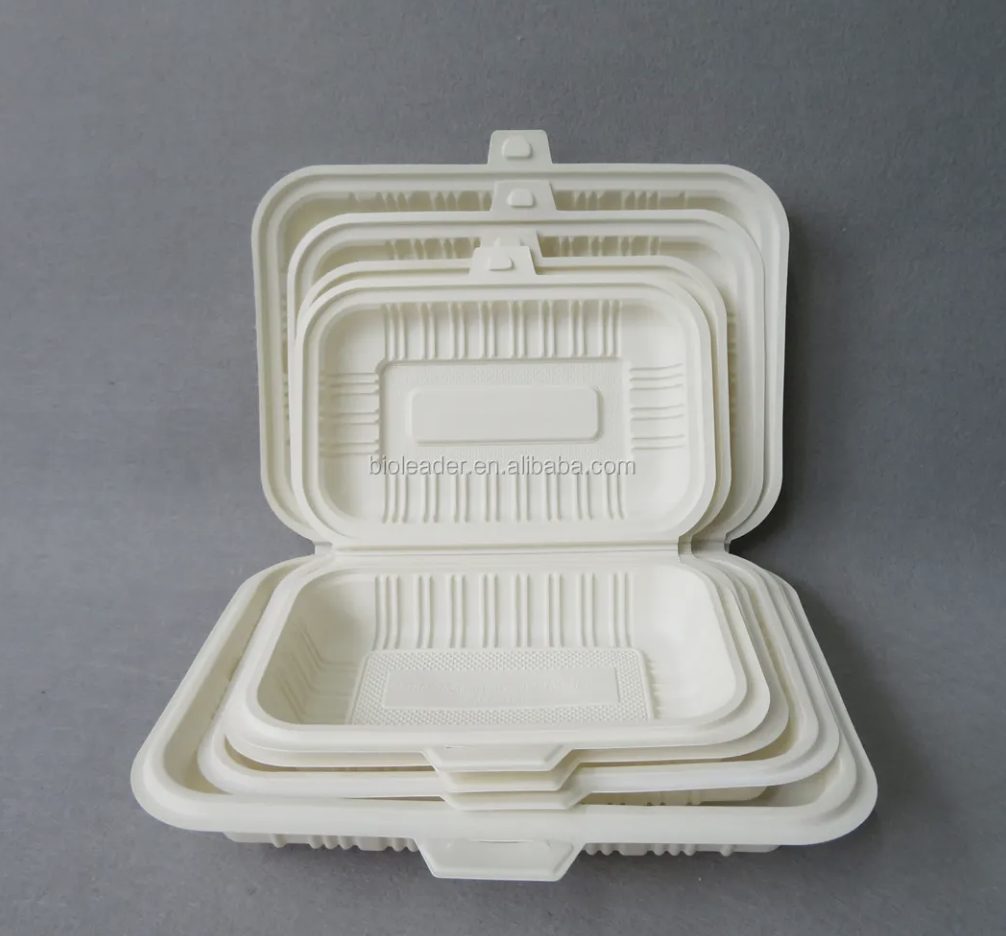Table of Contents
Plastic packaging is one of the biggest conveniences in the modern world. So much so that people, unfortunately, are unaware of the effect it has on our planet’s environment.
The plastic waste ending up in our landfills and oceans takes years to degrade. And even when it does, it will persist as microplastics, further threatening the health of Earth’s ecosystems.
In light of this problem, biodegradable alternatives made from plant-derived materials were invented. One such material is cornstarch.

What are cornstarch packaging boxes?
Cornstarch packaging boxes are biodegradable boxes made from cornstarch.
These boxes come in a variety of sizes and shapes to fit all manner of practical applications. These include clamshell containers, multi-compartment bento boxes, drink cartons, and soup containers.
What is cornstarch packaging made of?
Cornstarch packaging is made out of cornstarch (or corn flour as it is known in the UK).
Cornstarch is a flour-like substance made using starch extracted from corn grain, specifically from the corn kernel’s endosperm. It is almost 100% starch without fiber, protein, fat, or other components.
It appears as a very fine, chalky white powder and’ squeaks’ when you rub it between your fingers.
Traditionally, cornstarch is a thickening agent in sauces and custards and a crucial component in gluten-free baking.
Recently, cornstarch has become vital in the manufacturing of sustainable, biodegradable plastic and styrofoam substitutes.
What are cornstarch packaging boxes used for?
Cornstarch packaging boxes are used for a variety of purposes, including those listed below:
- Food packaging: Cornstarch is 100% food-safe, making it a good choice for packaging food.
Read: Cornstarch food packaging - Food storage: Due to its natural oil- and fat-resistance, cornstarch packaging can be used to stuff nuts and other oily foodstuffs.
- Dining events: Cornstarch takeaway food containers provide a more sustainable option for dining or catering events.
- Takeaway or food delivery: Cornstarch packaging is well-suited for takeaway or food delivery due to its non-toxicity and high oil and aroma resistance. Some packaging is even microwave-safe.
- Shipping: Adding plant oils to the cornstarch matrix will improve the strength of the resulting packaging. This, combined with its UV resistance and low flammability, makes it excellent for shipping and delivery.
Advantages and disadvantages of cornstarch packaging boxes
While much more eco-friendly than plastic, cornstarch has its own set of pros and cons.
Advantages of cornstarch
Cornstarch packaging offers a more environmentally friendly alternative to plastic and styrofoam due to the following advantages:
- Renewable: Corn is a staple crop, making it both abundant and readily available.
- Biodegradable: Cornstarch will naturally break down and decompose into base elements that will not harm the environment like other plant-based materials.
- Compostable: Cornstarch packaging can be converted into eco-friendly fertilizer at industrial composting facilities as it falls within the criteria of compostable plastics.
Read: Biodegradable vs compostable products - Recyclable: Cornstarch packaging can be recycled at dedicated facilities. The materials derived from it can be used to make other eco-friendly products such as plates or cups.
- Non-toxic: Does not contain harmful chemicals like dioxin or polyvinyl chloride.
- Reduced wastage and pollution: Cornstarch is biodegradable and compostable, so it will not take up space in landfills or release harmful substances into the environment.
- Low carbon emissions: Cornstarch production emits less greenhouse gas than conventional plastic production.
- Resistant to oils and fats: Suitable for containing oily foods.
- Resistant to UV: Reliable for products that need to be protected from UV radiation.
- Low flammability: There is less risk of fire when using cornstarch packaging.
- High aroma barrier: Prevents food from losing its aromas or being contaminated with unsavory smells.
- Printer-friendly: Businesses can brand cornstarch packaging without causing harm to the environment while also offering a high-quality customer experience.
- Increased marketability and brand recognition: Sustainably-minded consumers are drawn towards companies adopting environmentally friendly practices.
Disadvantages of cornstarch
It is, however, vital that you understand the current limitations and disadvantages of switching to cornstarch packaging:
- Cannot be composted at home: Cornstarch packaging can only be decomposed in a commercial composting facility’s hot and humid environment. Thus, it cannot be composted in a home compost pile or bin.
- Recycling contamination: Improper disposal can lead to contamination within the recycling stream.
- Customer behavior: Most people are unfamiliar with cornstarch packaging and don’t compost or dispose of the material properly. This could lead to cornstarch packaging ending up in landfills or contaminating other recycling streams.
- Methane gas emissions: If left to decompose in landfills, cornstarch packaging releases methane, a more potent greenhouse gas than carbon dioxide.
- Acidic: Composting large amounts of cornstarch can make the soil acidic.
- Limited infrastructure: Because cornstarch as a packaging material is relatively new, there are currently only a few infrastructures to support its manufacture, composting, or recycling.
- May affect food production: Being derived from a staple crop, excessive use of cornstarch packaging may disrupt the global food supply chain.
- High production costs: Cornstarch packaging is expensive, making it impractical for some businesses, especially SMEs and start-ups.
Where can we buy cornstarch packaging boxes?
Major online suppliers like Alibaba offer cornstarch packaging boxes of different sizes and varieties in bulk quantities.

FAQ
Are cornstarch packaging boxes recyclable?
Yes. Cornstarch packaging can be recycled, but to prevent contamination of the recycling stream, it must be delivered to a specialized recycling facility.
Are cornstarch packaging boxes biodegradable?
Yes, cornstarch packaging is biodegradable. One of cornstarch’s chief advantages over plastic is that it can be decomposed by the natural action of microorganisms in the soil. This ensures that its base substances are returned to the environment, thus leaving behind little to no waste.
Are cornstarch packaging boxes compostable?
Yes. Cornstarch packaging can be composted, but only under specific conditions. These conditions cannot be recreated at your home. Thus, delivering cornstarch packaging trash to dedicated composting facilities is better.
Cornstarch plastic decomposes within two months in a high-humidity composting environment at 60°C or 140°F.
Are cornstarch packaging boxes waterproof?
While not completely waterproof, cornstarch packaging does offer a degree of water resistance, protecting its contents from light moisture.
However, if exposed to heavy moisture, the packaging will become soggy and non-reusable.
Wax or polymer coatings can improve the water resistance of cornstarch packaging without contaminating it with toxic chemicals.
There are also specific formulations of cornstarch that can provide greater water resistance via particular processing techniques.
Are cornstarch packaging boxes flammable?
Cornstarch packaging has low flammability and high heat resistance. Some cornstarch takeaway packaging is even microwave-safe.
Regardless, placing your cornstarch packaging in a place with a high fire hazard risk is still not recommended.
Can cornstarch packaging boxes be used to store food?
Yes. Cornstarch by itself contains no harmful chemicals and is 100% food-safe. Additionally, it has a strong aroma barrier. It is highly resistant to oils, fats, and heat without the need for extra coatings or additives.
There is a great variety of cornstarch food packaging boxes available on the market, including clamshell containers, multi-compartment bento boxes, and soup containers.
Is cornstarch packaging better than plastic?
Compared to single-use plastic, cornstarch can be made into a similar material with equal strength, durability, and versatility. Unlike conventional plastics, cornstarch plastic is biodegradable and compostable, and its production has a lower carbon footprint.
These qualities make cornstarch plastic a more environmentally friendly option for consumers and businesses.
Is cornstarch packaging better than cardboard?
Yes. Compared to cardboard, cornstarch packaging has a more energy-efficient production that uses up fewer resources while also emitting lower levels of carbon dioxide.
Additionally, cornstarch requires chemical additives, making it safer for food. And it is more lightweight than cardboard, reducing transportation costs.
Finally, corn grows faster than trees, making it far more sustainable as a resource.
Is cornstarch packaging cheap?
Currently, cornstarch packaging is more expensive than plastic. While improvement in the production process has dramatically lowered the costs of cornstarch packaging, it is still more costly than plastic.
That said, cornstarch is sourced from an abundant and renewable resource, so that it will be a far more cost-effective investment than petroleum-based plastics.
How long does cornstarch packaging last?
Cornstarch packaging has a long shelf life, provided that the conditions are conducive to a long life.
It takes very specific temperatures and humidity in order for cornstarch packaging to start breaking down.
Cornstarch packaging in the future
Cornstarch packaging is already seeing widespread usage in food packaging. And it has even greater potential to replace cardboard in shipping and delivery completely.
Its production is still quite expensive, however. This, combined with potentially causing problems in the global food supply chain, prevents cornstarch from being totally sustainable. As such, more investments and developments are required to overcome these issues and make cornstarch more viable in the future.
By making the switch to cornstarch packaging boxes, you’ll not only advertise your commitment to sustainability but also raise awareness of this environmentally friendly product amongst the public.
As we move towards a plastic-free future, making the jump to biodegradable packaging will ensure you and your brand’s continued success.

